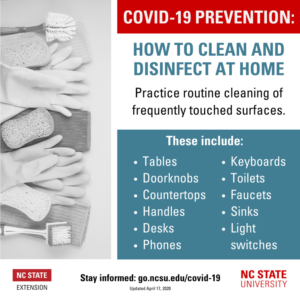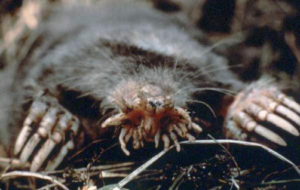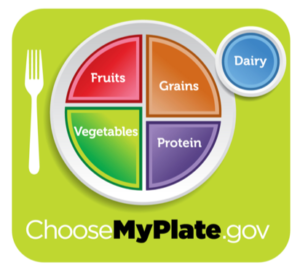Home Insteading With Cooperative Extension (Week 10)
go.ncsu.edu/readext?695040
en Español / em Português
El inglés es el idioma de control de esta página. En la medida en que haya algún conflicto entre la traducción al inglés y la traducción, el inglés prevalece.
Al hacer clic en el enlace de traducción se activa un servicio de traducción gratuito para convertir la página al español. Al igual que con cualquier traducción por Internet, la conversión no es sensible al contexto y puede que no traduzca el texto en su significado original. NC State Extension no garantiza la exactitud del texto traducido. Por favor, tenga en cuenta que algunas aplicaciones y/o servicios pueden no funcionar como se espera cuando se traducen.
Português
Inglês é o idioma de controle desta página. Na medida que haja algum conflito entre o texto original em Inglês e a tradução, o Inglês prevalece.
Ao clicar no link de tradução, um serviço gratuito de tradução será ativado para converter a página para o Português. Como em qualquer tradução pela internet, a conversão não é sensivel ao contexto e pode não ocorrer a tradução para o significado orginal. O serviço de Extensão da Carolina do Norte (NC State Extension) não garante a exatidão do texto traduzido. Por favor, observe que algumas funções ou serviços podem não funcionar como esperado após a tradução.
English
English is the controlling language of this page. To the extent there is any conflict between the English text and the translation, English controls.
Clicking on the translation link activates a free translation service to convert the page to Spanish. As with any Internet translation, the conversion is not context-sensitive and may not translate the text to its original meaning. NC State Extension does not guarantee the accuracy of the translated text. Please note that some applications and/or services may not function as expected when translated.
Collapse ▲4-H at Home
Camaryn Byrum, 4-H Agent
Choose MyPlate
MyPlate is a nutrition guide, published by the USDA, that encourages eating meals that incorporate the five foods groups: fruits, vegetables, grains, protein, and dairy. Eating a variety of foods from the different groups will help you grow, give you energy, and help prevent you from getting sick. The amount of each food group you need depends on your age, sex, and level of physical activity. For more information on MyPlate, visit: ChooseMyPlate.
Fruits: Any fruit or 100% fruit juice falls into the Fruit Group. The fruits you choose can be fresh, canned, frozen, or dried.
Vegetables: Any vegetable or 100% vegetable juice counts as the Vegetable Group. Vegetables can be raw, cooked, fresh, frozen, canned, dried, or dehydrated. Vegetables are typically organized into 5 subgroups: dark-green vegetables, starchy vegetables, red and orange vegetables, beans and peas, and other vegetables.
Grains: Any food items made from wheat, rice, oats, cornmeal, barley, and cereal grains are in the Grain Group. Items like bread, pasta, cereal, grits, popcorn, rice, and oatmeal all fall within this food group.
Protein: Foods made from meat, poultry, seafood, beans, eggs, soy products, nuts, and seeds are all considered part of the Protein Group.
Dairy: Fluid milk products and many foods made from milk that hold their calcium content (like yogurt and cheese) are part of the Dairy Group.
Now that we’ve learned a little about each of the five food groups, let’s make a sundae that contains 4/5 of the food groups. Recipe from: NC 4-H Cooking Up Confidence Cookbook.
Nearly a Five-Group Sundae
Ingredients
- 1 cup low-fat vanilla yogurt
- 2 tablespoons of nuts or seeds (cashews, peanuts, almonds, pecans)
- ¼ cup fresh or frozen fruit of choice (bananas, strawberries, blueberries)
- Small handful of crushed graham crackers
Directions
- Assemble the sundae in layers, using the ingredients of choice (from above)
Reflection
- What food group does the yogurt fall under?
- What food group do the nuts and seeds fall under?
- What food group do the berries fall under?
- What food group do the graham crackers fall under?
- Which food group is missing from this recipe? How could you incorporate that food group into this recipe?
Family and Consumer Sciences at Home
Mary Morris, County Extension Direction & Family and Consumer Sciences Agent
Don’t Forget to Clean Common Touchpoints
We have heard if not once a thousand times wash your hands, wear your face masks in public, use hand sanitizer but we also need to pay attention to any common touchpoints in our homes, offices, and cars. Now that we are entering into Phase 2 of the Governor’s order we will be moving around more and more. Make sure to continue to follow the CDC guidelines and NCDHHS “Know Your W’s” (Wear a Face Mask, Wait 6ft Apart, Wash Your Hands) when out in public. Be sure to pay attention to your home also. You will want to clean and disinfect all common touchpoints. Common touchpoints are those places that are touched naturally by you and visitors (doorknobs, handles, switches).
These areas need to be cleaned and sanitized several times a day to prevent the transmission of COVID-19. Use your alcohol-based hand sanitizer for your hands and sanitize hard surfaces with a bleach or other type of sanitizer. The easiest is sanitizer wipes or you can use spray sanitizer. The cheapest is a bleach solution of (4 tsp bleach/ per 1-quart water). There is a difference in cleaning and sanitizing, cleaning is using soap to clean surfaces to remove things you can see dirt or food. Sanitizing is taking the extra step to spray or wipe down with a sanitizer that will kill germs and pathogens. For more information go to: go.ncsu.edu/covid-19.
For the CDC’s recommendations on how to clean and disinfect, visit the CDC website. 
Horticulture at Home
Katy Shook, Area Horticulture Agent
Moles or Voles
Is it a mole or vole making tunnels in your yard? It’s probably a mole. Moles, which are often confused with voles, are carnivores that feed on grubs, earthworms, ants, beetles, and other underground insects. Unlike voles, moles do not feed on vegetative material but can cause damage to plant roots as they “swim” through the soil. Voles are the pests feeding on plant roots; they rarely create visible tunnels and are more similar in appearance to a mouse.
Controlling either animal is difficult. Some moles are protected by state laws and require permits for trapping or killing. Because moles frequently take advantage of areas with weak turf, homeowners can try to boost the turf with fertilizer to discourage tunneling. Home remedies are not effective at discouraging or killing moles. Killing the food source is sometimes an option, but only if the insects are in very high numbers and causing additional damage; keep in mind that the mole is naturally controlling the insects. Controlling voles can be achieved with methods similar to mouse control. Always follow all label directions. Discourage voles by reducing overgrown, weedy areas in the landscape, and interplanting with vole resistant plants and products. Natural biological controls like predatory birds, snakes, and even feral cats will also help keep populations in check.
Remember – moles eat “meat”; voles eat “vegetation.” For more information on managing moles or voles, contact the N.C. Cooperative Extension of Chowan County office at (252) 482-6585. Pictured: A star-nosed mole
Pictured: A star-nosed mole




